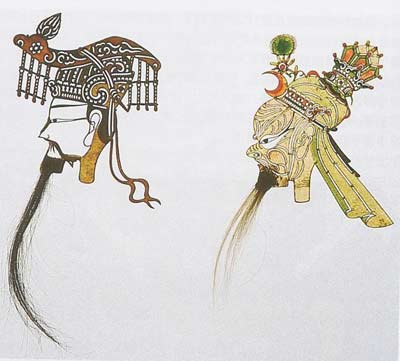 Longdong Shadow Plays
Longdong Shadow Plays
Shadow plays are a folk art, and the Longdong shadow plays originated in rural areas of China's Gansu andShaanxi provinces, as well as theNingxia Hui Autonomous Region.
Such art was popular during the Ming and Qing dynasties. Figures used Longdong plays look pretty and charming, while their carving is the work of greatly skilled carvers.
The material used for Longdong shadow plays is ox skin that must be durable and soft and with just the right thickness. To make the puppets, people first clean and dry the skin (after drawing and carving the material). Then, they put it in water to add color and take it out to iron it, which is the hardest yet most important step. Lastly, the skin is dried and bound together before being used in performances.

The two figures in the picture are the supreme deity of Taoism and the Lao-tzu by Taoists. Craft of the Lao-tzu by Taoists are complicated and the figure can be moved flexibly. The main colors used are red, yellow, black, and green. However, the figure can display more subtle colors with complicated patterns.
The supreme deity of Taoism has long and thin eyes, a small mouth, and a steep nose bridge, giving people an impression that he is mild and generous. The Lao-tzu by Taoists has round eyes, a flat nose, and a pointed forehead, looking energetic and vital.
Shadow plays emphasize performance. By performers moving every part of the body to inspire strains of songs, an entire single play displays strong local characteristics.
